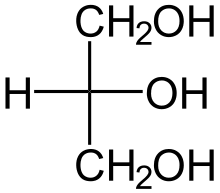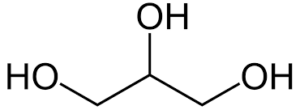In this article we will get to know about glycerol structure, its properties and uses.
Glycerol is a polyol, which means it has more than one hydroxyl group. Its chemical structure has three hydroxyl groups, which are -OH groups bonded to carbon atoms. Glycerol is made up of three carbon atoms, three oxygen atoms, and eight hydrogen atoms.
Glycerol is a basic polyol molecule that is also known as glycerin. Glycerol is a colourless, odourless, viscous, non-toxic, and sweet-tasting liquid. Triglycerides, which are lipids with a glycerol backbone, contain the glycerol backbone.
Glycerol’s chemical formula is C3H8O3.
Glycerine (also spelled glycerol) is a viscous, colourless, non-toxic, and simple triol chemical. Glycerol is utilised in dermatological treatments, and glycerin or glycerol offers a number of advantages. It is also employed as a preservative and sweetener in the food sector. Glycerol is an osmolyte, a solvent, a detergent, a human metabolite, a Saccharomyces cerevisiae metabolite, an E. coli metabolite, a mouse metabolite, an algal metabolite, and a geroprotector. Glycerol is a combination of trigol and alditol.
Glycerin, also known as glycerol, is a triol molecule that is found in both plant and animal lipids. For dermatological treatments, it is a dermatologist. Glycerol has been widely used as a biofuel in recent years. Glycerol is also a straightforward polyol molecule. Scientists have discovered that the backbone of the organism is made up of lipids known as glycerides. Because of its antiviral and antibacterial qualities, glycerol is commonly utilised in FDA-approved wound and burn therapies.
Glycerin is a trihydroxy alcohol that has osmotic diuretic and laxative properties. Glycerin elevates the osmolality of blood plasma by extracting water from tissues and transferring it to the interstitial fluid and plasma. Glycerol produces a chemical as a result of a reaction. Glycerin inhibits water reabsorption in the proximal tubule of the kidney, resulting in increased water and salt excretion as well as a decrease in blood volume. Glycerin relieves constipation by drawing water into the rectum and exerting a hyperosmotic laxative action.
1. Structure of Glycerol:
Glycerol is a trihydroxy sugar alcohol that has three carbon atoms and three hydroxyl groups. It is an organic polyol molecule with the IUPAC designation 1, 2, 3-Propanetriol due to the presence of several hydroxyl groups and carbon atoms.
Glycerol’s structure can be depicted in a variety of ways. In the diagram below, the basic backbone consists of three carbon atoms, each covalently bonded to a hydroxyl group. The molecule can also be represented as a Fischer projection centred on the second carbon atom, as seen in the image below.
Furthermore, without explicitly representing the hydrogen atoms, the molecule may be depicted with a more precise picture of bond angles.


2. Properties of Glycerol:
Glycerol’s three hydroxyl groups allow it to produce esters in interactions with a variety of organic acids. When long chain organic fatty acids are esterified to all three reactive groups, a triglyceride is formed. Triglycerides are a kind of lipid found in the human body.
The melting point of pure glycerol is 17.8°C. Although it has a boiling point of 290°C, it decomposes at that temperature. Because the chemical has three hydroxyl groups, it is hygroscopic, meaning it may collect moisture from the air. It may also be used as a humectant in cosmetics and food to maintain moisture and prevent the product from drying out.
Glycerol is easily soluble in water due to the polyol groups’ ability to form hydrogen bonds with water molecules. Glycerol has a specific gravity of 1.26, making it somewhat denser than water. This means that pouring glycerol into a glass of water will cause it to sink to the bottom. Due to its solubility, glycerol will form an aqueous solution over time and with mild agitation.
Glycerol can cause mild irritation to the eyes, nose, lungs, and skin due to its hygroscopic nature. When pure glycerol comes into touch with wet tissues like skin and internal organs, it can cause them to dry up. The same characteristic that makes glycerol an excellent humectant also desiccates interior tissues since it may bind to water. When a lotion, cream, or gel with a high water content is applied to the skin, the addition of glycerol can keep the lotion, cream, or gel from drying out too quickly, especially in arid climates.
3. Glycerol’s Uses:
- Glycerol is used to fuel diesel generators that provide energy.
- When filming sequences using water in the film business, it is important to keep regions from drying up too soon.
- Glycerol is used as a substitute for water in ultrasonic testing.
- Glycerol was utilized to create hydrogen gas.
- Glycerin is employed in a variety of pharmacological formulations as a solvent, humectant, and carrier.
- Glycerol is utilized as an emollient and hydrant in pharmaceutical and personal care compositions, such as glycerin soaps and laxatives.
- It is commonly used in molecular biology laboratories to prepare polyacrylamide electrophoresis gels for proteins.
- Themes preservation crio-agents are also used to store biosamples.
- Glycerol is also employed as a sweetener and preservative in meals; in particular, companies utilise it as a sugar substitute because it has less calories.
- Glycerol is also utilized in foods as a sweetener and preservative; in fact, companies employ it as a sugar substitute because it has less calories.
Hi….I am D N Madhusudan, I have completed my master’s in General Chemistry from the University of Mysore. Apart from this, I like to read and listen to Music.
Let’s connect through LinkedIn:
